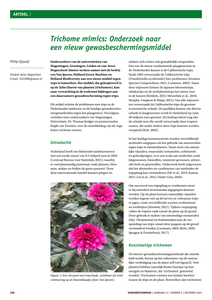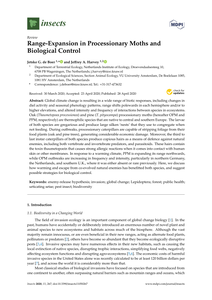Potato cyst nematodes (PCN) are in the Northern Netherlands and the Weser-Ems Region in Germany a major issue for farmers. The yearly average damage by PCN is about 100 Euros/hectare for farmers. Infestations of potato cyst nematodes can be controlled in a sustainable way by proper potato variety selection. Potato varieties vary in the degree of tolerance and resistance to PCN. However, this knowledge is used by only a small fraction of the farmers. The AGROBIOKON project, which is funded by the INTERREG EDR-region, the Landwirtschaftskammer Niedersachsen and the Dutch farmers association, have developed a decision support system for potato variety selection based upon population dynamic models for PCN: OPTIRas. The scientific principles and the model behind the decision support system will be presented. The model will be applied to PCN field experiments in the Weser-Ems region. Experience of using this decision support system in farmer study groups in the Netherlands and Germany will be shared.
DOCUMENT

Growth curve analysis of sedentary plant parasitic nematodes on different hosts and at different population densities is used to assess plant suitability including their resistance and tolerance. The estimated parameters of host suitability can be used in pest management programs for economic important species such as potato cyst nematodes.
LINK
Implementation of reliable methodologies allowing Reduction, Refinement, and Replacement (3Rs) of animal testing is a process that takes several decades and is still not complete. Reliable methods are essential for regulatory hazard assessment of chemicals where differences in test protocol can influence the test outcomes and thus affect the confidence in the predictive value of the organisms used as an alternative for mammals. Although test guidelines are common for mammalian studies, they are scarce for non-vertebrate organisms that would allow for the 3Rs of animal testing. Here, we present a set of 30 reporting criteria as the basis for such a guideline for Developmental and Reproductive Toxicology (DART) testing in the nematode Caenorhabditis elegans. Small organisms like C. elegans are upcoming in new approach methodologies for hazard assessment; thus, reliable and robust test protocols are urgently needed. A literature assessment of the fulfilment of the reporting criteria demonstrates that although studies describe methodological details, essential information such as compound purity and lot/batch number or type of container is often not reported. The formulated set of reporting criteria for C. elegans testing can be used by (i) researchers to describe essential experimental details (ii) data scientists that aggregate information to assess data quality and include data in aggregated databases (iii) regulators to assess study data for inclusion in regulatory hazard assessment of chemicals.
DOCUMENT

Field experiments were carried out in 1991 and 1992 on sandy soil highly infested with the potato cyst nematode Globodera pallida. Half the trial area was fumigated with nematicide to establish two levels of nematode density. Three levels of soil compaction were made by different combinations of artificial compaction and rotary cultivation. Two potato cultivars were used in 1991 and four in 1992. Both high nematode density and soil compaction caused severe yield losses, of all cultivars except cv. Elles which was tolerant of nematode attack. The effects of the two stress factors were generally additive. Analysis of the yield loss showed that nematodes mainly reduced cumulative interception of light while compaction mainly reduced the efficiency with which intercepted light was used to produce biomass. This indicates that nematodes and compaction affect growth via different damage mechanisms. Nematodes reduced light interception by accelerating leaf senescence, by decreasing the specific leaf area and indirectly by reducing overall crop growth rate. Partitioning of biomass between leaves, stems and tubers was not affected by nematode infestation but compaction decreased partitioning to leaves early in the growing season while increasing it during later growth stages. The effects of nematodes and compaction on root length dynamics and nutrient uptake were also additive. This suggests that the commonly observed variation in yield loss caused by nematodes on different soil types is not related to differences in root system expansion between soils of various strength. Cv. Elles, which showed tolerance of nematodes by relatively low yield losses in both experiments, was characterised by high root length density and thick roots. These characteristics did not confer tolerance of soil compaction, since compaction affected root lengths and tuber yields equally in all cultivars. In the first experiment only, high nematode density led to decreased root lengths and lower plant nutrient concentrations. The yield loss which occurred in the second experiment was attributed to the effects of nematodes on other aspects of plant physiology. Copyright © 1995, Wiley Blackwell. All rights reserved
DOCUMENT
From the article: "To enable selection of novel chemicals for new processes, there is a recognized need for alternative toxicity screening assays to assess potential risks to man and the environment. For human health hazard assessment these screening assays need to be translational to humans, have high throughput capability, and from an animal welfare perspective be harmonized with the principles of the 3Rs (Reduction, Refinement, Replacement). In the area of toxicology a number of cell culture systems are available but while these have some predictive value, they are not ideally suited for the prediction of developmental and reproductive toxicology (DART). This is because they often lack biotransformation capacity, multicellular or multi- organ complexity, for example, the hypothalamus pituitary gonad (HPG) axis and the complete life cycle of whole organisms. To try to overcome some of these limitations in this study, we have used Caenorhabditis elegans (nematode) and Danio rerio embryos (zebrafish) as alternative assays for DART hazard assessment of some candidate chemicals being considered for a new commercial application. Nematodes exposed to Piperazine and one of the analogs tested showed a slight delay in development compared to untreated animals but only at high concentrations and with Piperazine as the most sensitive compound. Total brood size of the nematodes was also reduced primarily by Piperazine and one of the analogs. In zebrafish Piperazine and analogs showed developmental delays. Malformations and mortality in individual fish were also scored. Significant malformations were most sensitively identified with Piperazine, significant mortality was only observed in Piperazine and only at the higest dose. Thus, Piperazine seemed the most toxic compound for both nematodes and zebrafish. The results of the nematode and zebrafish studies were in alignment with data obtained from conventional mammalian toxicity studies indicating that these have potential as developmental toxicity screening systems. The results of these studies also provided reassurance that none of the Piperazines tested are likely to have any significant developmental and/or reproductive toxicity issues to humans when used in their commercial applications."
LINK
Summary: Xpaths is a collection of algorithms that allow for the prediction of compound-induced molecular mechanisms of action by integrating phenotypic endpoints of different species; and proposes follow-up tests for model organisms to validate these pathway predictions. The Xpaths algorithms are applied to predict developmental and reproductive toxicity (DART) and implemented into an in silico platform, called DARTpaths.
DOCUMENT

Onderzoekers van de universiteiten van Wageningen, Groningen, Leiden en van Aeres Hogeschool Almere werken samen met de bedrijven Van Iperen, Holland Green Machine en Holland Biodiversity aan een nieuw middel tegen trips in kasteelten. Het middel, dat geïnspireerd is op de (klier)haren van planten (trichomen), kan naar verwachting in de toekomst bijdragen aan een duurzamere gewasbescherming tegen trips.
DOCUMENT

Global climate change is resulting in a wide range of biotic responses, including changes in diel activity and seasonal phenology patterns, range shifts polewards in each hemisphere and/or to higher elevations, and altered intensity and frequency of interactions between species in ecosystems.Oak (Thaumetopoea processionea) and pine (T. pityocampa) processionary moths (hereafter OPM and PPM, respectively) are thermophilic species that are native to central and southern Europe. The larvae of both species are gregarious and produce large silken ‘nests’ that they use to congregate when not feeding. During outbreaks, processionary caterpillars are capable of stripping foliage from theirfood plants (oak and pine trees), generating considerable economic damage. Moreover, the third to last instar caterpillars of both species produce copious hairs as a means of defence against naturalenemies, including both vertebrate and invertebrate predators, and parasitoids. These hairs contain the toxin thaumetopoein that causes strong allergic reactions when it comes into contact with humanskin or other membranes. In response to a warming climate, PPM is expanding its range northwards, while OPM outbreaks are increasing in frequency and intensity, particularly in northern Germany,the Netherlands, and southern U.K., where it was either absent or rare previously. Here, we discuss how warming and escape from co-evolved natural enemies has benefitted both species, and suggest possible strategies for biological control.
DOCUMENT
